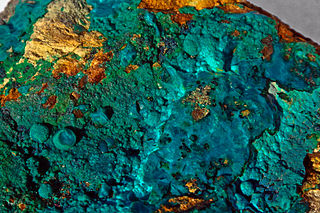Related Research Articles

In geology and mineralogy, a mineral or mineral species is, broadly speaking, a solid chemical compound with a fairly well-defined chemical composition and a specific crystal structure, that occurs naturally in pure form.

Hornblende is a complex inosilicate series of minerals. It is not a recognized mineral in its own right, but the name is used as a general or field term, to refer to a dark amphibole.

Amphibole is a group of inosilicate minerals, forming prism or needlelike crystals, composed of double chain SiO
4 tetrahedra, linked at the vertices and generally containing ions of iron and/or magnesium in their structures. Amphiboles can be green, black, colorless, white, yellow, blue, or brown. The International Mineralogical Association currently classifies amphiboles as a mineral supergroup, within which are two groups and several subgroups.

Silicate minerals are rock-forming minerals made up of silicate groups. They are the largest and most important class of minerals and make up approximately 90 percent of Earth's crust.

Glaucophane is the name of a mineral and a mineral group belonging to the sodic amphibole supergroup of the double chain inosilicates, with the chemical formula ☐Na2(Mg3Al2)Si8O22(OH)2.

Lamprophyres are uncommon, small volume ultrapotassic igneous rocks primarily occurring as dikes, lopoliths, laccoliths, stocks and small intrusions. They are alkaline silica-undersaturated mafic or ultramafic rocks with high magnesium oxide, >3% potassium oxide, high sodium oxide and high nickel and chromium.
Frank Christopher Hawthorne is a Canadian mineralogist and crystallographer.
Normative mineralogy is a calculation of the composition of a rock sample that estimates the idealised mineralogy of a rock based on a quantitative chemical analysis according to the principles of geochemistry.

The endmember hornblende tschermakite (☐Ca2(Mg3Al2)(Si6Al2)O22(OH)2) is a calcium rich monoclinic amphibole mineral. It is frequently synthesized along with its ternary solid solution series members tremolite and cummingtonite so that the thermodynamic properties of its assemblage can be applied to solving other solid solution series from a variety of amphibole minerals.

Betafite is a mineral group in the pyrochlore supergroup, with the chemical formula (Ca,U)2(Ti,Nb,Ta)2O6(OH). Betafite typically occurs as a primary mineral in granite pegmatites, rarely in carbonatites. Defined by the B-site atom Ti, Atencio et al.(2010) combined and considered the ideas portrayed in (Hatert and Burke)(2008) and a modernization of (Hogarth)(1977) system for nomenclature of pyrochlore and betafite in order to further rationalize the naming process of this grouping of minerals. Therefore, Atencio et al. (2010), states that only two of the mineral species that were formerly recognized under the previous nomenclature system of betafite in Hogarth (1977) are now recognized. They are oxyuranobetafite and oxycalciobetafite. Now the term betafite is a synonym or varietal group name under the pyrochlore super group (Christy and Atencio 2013).

Edenite is a double chain silicate mineral of the amphibole group with the general chemical composition NaCa2Mg5(Si7Al)O22(OH)2. Edenite is named for the locality of Edenville, Orange County, New York, where it was first described.

Ferrogedrite is an amphibole mineral with the complex chemical formula of ☐Fe2+2(Fe2+3Al2)(Si6Al2)O22(OH)2. It is sodium and calcium poor, making it part of the magnesium-iron-manganese-lithium amphibole subgroup. Defined as less than 1.00 apfu (atoms per formula unit) of Na + Ca and consisting of greater than 1.00 apfu of (Mg, Fe2+, Mn2+, Li) separating it from the calcic-sodic amphiboles. It is related to anthophyllite amphibole and gedrite through coupled substitution of (Al, Fe3+) for (Mg, Fe2+, Mn) and Al for Si. and determined by the content of silicon in the standard cell.

Timothy John Barrington Holland is a petrologist and reader in the Department of Earth Sciences at the University of Cambridge.
Fluorcarmoite-(BaNa) is a rare phosphate mineral, belonging to arrojadite group, with the formula Ba[]Na2Na2[]CaMg13Al(PO4)11(PO3OH)F2. It is a barium-rich member of the group, as is arrojadite-(BaNa), arrojadite-(BaFe), fluorarrojadite-(BaFe) and an unapproved species ferri-arrojadite-(BaNa). The "-(BaNa)" suffix informs about the dominance of the particular elements (here barium and sodium) at the corresponding structural sites.
Ferro-ferri-hornblende is an amphibole-supergroup mineral with the formula ☐Ca2(Fe2+4Fe3+)(Si7Al)O22(OH)2. It contains essential vacancy (☐). It was discovered in the Traversella mine, Canavese, Torino, Piedmont, Italy.
In geology and mineralogy, a mineral group is a set of mineral species with essentially the same crystal structure and composed of chemically similar elements.
References
- 1 2 "Ferri-obertiite: Ferri-obertiite mineral information and data". Mindat.org. Retrieved 2016-03-04.
- 1 2 Oberti, R., Boiocchi, M., Hawthorne, F.C., Ball, N.A., and Blass, G., 2015. Ferri-obertiite, IMA 2015-079. CNMNC Newsletter No. 28, December 2015, page ; Mineralogical Magazine 79, 1859–1864
| This article about a specific silicate mineral is a stub. You can help Wikipedia by expanding it. |